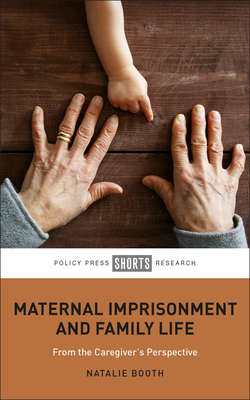Читать книгу Maternal Imprisonment and Family Life - Booth Natalie - Страница 7
ОглавлениеA woman in her 50s approaches me. In one hand, she is carrying two, slightly torn black bin bags bulging with clothes, while the other hand rests on a pram where a little bundle of joy lies asleep. It is January and despite only just coming inside from the cold street, her forehead is shiny with small droplets of perspiration. Her face is drawn, her body vibrating a little. Her mouth does not move, but she speaks to me. I feel her eyes desperately search my face for an indication of hope, and this tells me that she needs my help.
One bus, two trains and a 40-minute walk later, Linda has arrived. Linda is not her real name of course, but she is a real person. Linda has not been to a prison before. Then again, neither has Linda’s daughter. She tells me this while scanning the room suspiciously. I explain that we are sat a little outside the prison in the prison visitor’s centre and that I work with the prison family support team. We drink a cup of tea together, and I try to answer her questions: “Do I have the right ID for the visit?”; “Who do I give the bin bags of clothes to?”; “Is she safe?” I learn that Linda is proud to be Nana to the bundle of joy still asleep in the pram, as well as to two little blonde-haired boys – one aged seven and one aged five. Fighting back tears, she tells me that the children have not seen their mum since Thursday morning. She tells me that the teachers had phoned her and asked her to collect the boys from school. Linda had been confused and worried but she went, still wearing her bright green ASDA T-shirt, and was perspiring much like she is today – except today is Tuesday.
Linda said that her daughter had been summoned to court on Thursday, but until the school had phoned, she had thought nothing of it. She explained that the solicitor had reassured them that a non-violent, first-time offence like her daughter’s – and especially a sole carer to three little boys – would not result in a custodial sentence. Since Thursday, Linda had spoken to her daughter once: a telephone call lasting no more than six minutes. Although Linda suspected that her daughter was in prison, this phone call confirmed her dreaded suspicions; however, six minutes was not long enough to ask all the questions that she had about the boy’s bath-and-bedroom routine, or to establish what alternative to breast milk she should give the baby. It also confirmed that Linda would not be donning her green ASDA T-shirt for the next six months. How could she? Her grandsons needed her.
Contextualising Linda’s story: a note on the research
Linda is the first caregiver that I had the privilege of meeting. Her story not only stayed with me, but was an inspiration and motivation to conduct the research that underpins this book. Linda committed no infractions herself – she frequently joked that she had never even received a parking ticket; yet, from that Thursday onwards, Linda’s life was turned upside down.
Prisons remain on the periphery of our society; we know that they exist and yet because only a small proportion of people come into direct contact with them, it is difficult to gain a real understanding of their essence and functioning. Prior to this study, my personal history had not afforded much contact with the prison setting – and my knowledge of maternal imprisonment was born entirely out of my academic interest. Given my own positionality, I decided that it was appropriate and justified to acquaint myself with the prison environment and learn more about the complexities of the environment first-hand. This is why I organised and embarked on a six-month placement at the women’s prison. This placement is where I met Linda, as well as other relatives like her who were in contact with women in prison. Working in the prison provided familiarity with the prison and, importantly, the familial experience of prison. The lessons I learned during these six months subsequently guided the research aims and methods that underpin the study presented in this book.
It is because my meeting with Linda occurred before the research began that she is not one of the 15 families whose experiences are presented later in the book. However, I hope that by beginning with Linda’s experience, you, the reader, will be encouraged to learn more about what happens to grandmothers like Linda, and will join me on this exploration of Maternal Imprisonment and Family Life: From the Caregiver’s Perspective.
